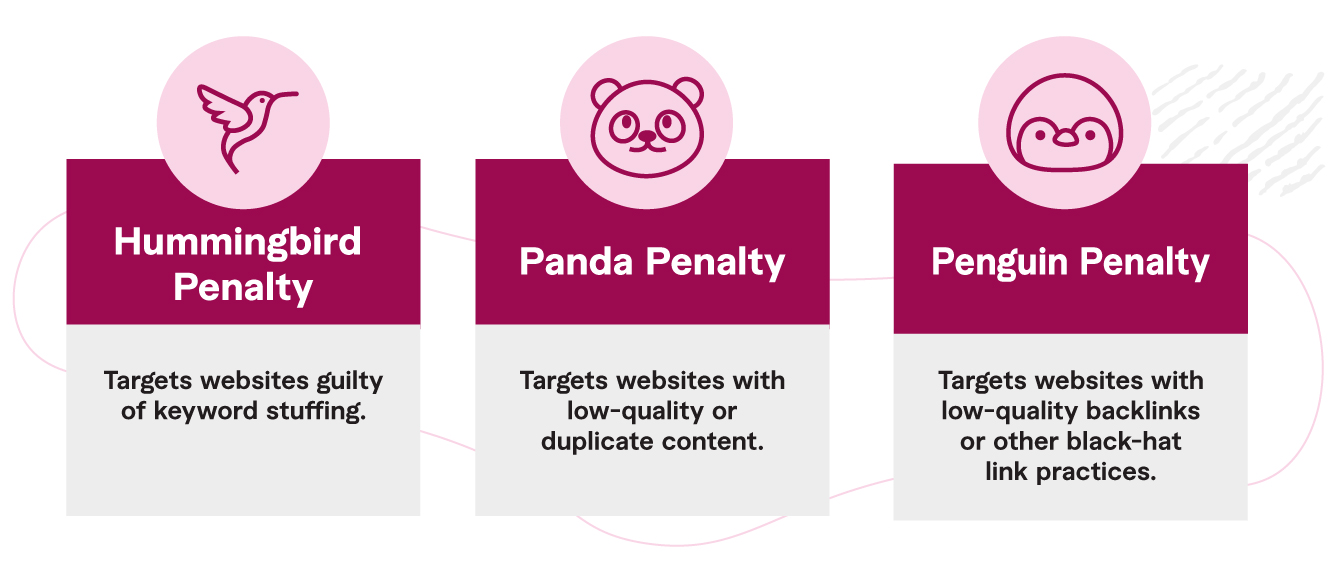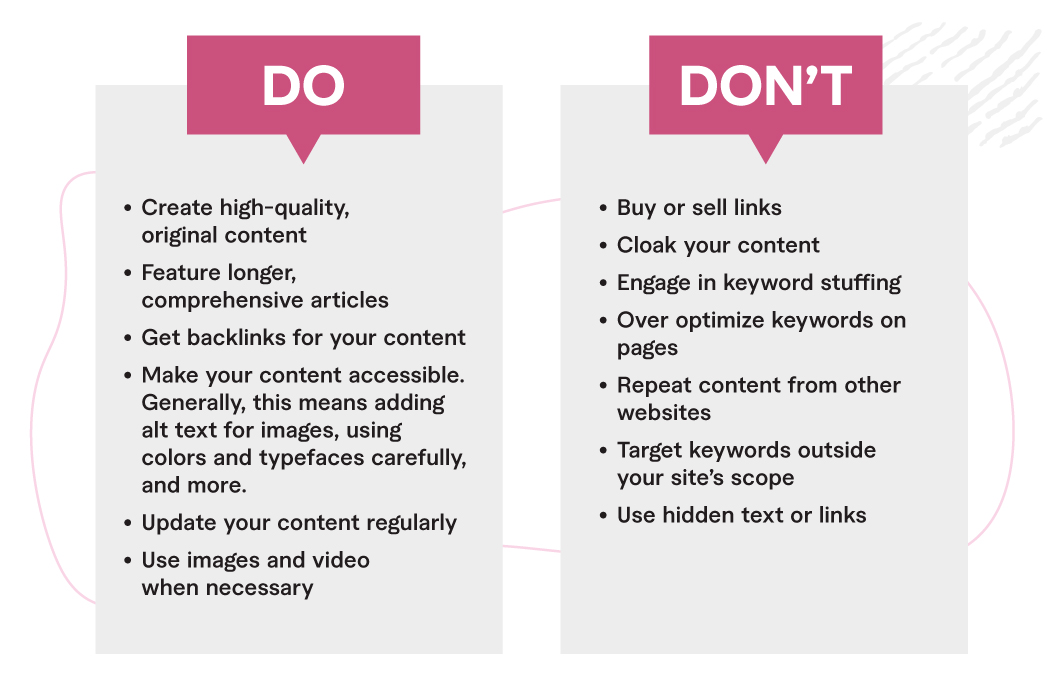When it comes to creating content, do all the right things and you’ll see your Google rankings rise. But just as suddenly, you can be penalized by Google, and see your traffic and search engine rankings drop.
What happened? And what happens now?
As a website owner or digital marketer, you need to be aware of these penalties, which Google can impose on your website if it believes you have violated its guidelines.
Here’s what to know about Google penalties, how to avoid them, and what to do if you’re hit with one.
How Can Google Penalize Your Website?
Google penalties can hit you hard, so you need to keep an eye on your traffic and search engine rankings to be sure you’re staying on their good side. Periodically check into Google Analytics to see how your website is doing – which you should be doing anyway to optimize your traffic.
There are a few ways that Google can penalize your website.
Algorithmic Penalties
Google uses algorithms to evaluate websites and rank them in search results. If your website is found to be in violation of these algorithms, it may be penalized.
Some of the most common algorithmic penalties include:
- Hummingbird Penalty: This penalty targets websites that use keyword stuffing (filling a webpage with keywords in an attempt to manipulate search results) or that have thin content.
- Panda Penalty: This penalty targets websites with low-quality or duplicate content.
- Penguin Penalty: This penalty targets websites with low-quality backlinks or those that engage in link schemes.
Algorithmic penalties can be difficult to detect and can result in a gradual decline in your website’s search engine rankings. Google won’t notify you if you’re penalized, though. You’ll have to figure it out yourself, as outlined below.
Deindexing
In extreme cases, Google may deindex your website entirely. This means that your website will not appear in any Google search results, and you will lose all of your organic traffic.
Deindexing usually occurs as a result of severe violations of Google’s guidelines, such as hosting illegal content or engaging in spammy practices such as attempting to manipulate searches.
Manual Penalties
Google has a team of human reviewers who manually evaluate websites to ensure that they comply with Google’s guidelines. If they find that your website is violating these guidelines, they may impose a manual penalty.
Manual penalties can be severe and can result in your website being removed from Google’s search results. Some common reasons for manual penalties include:
- Engaging in deceptive practices like cloaking (showing different content to search engines for ranking purposes than that shown to visitors) or hidden text (content that isn’t visible to a visitor but intended to add more keywords)
- Hosting malware or spammy content
- Using “black hat” SEO tactics like keyword stuffing, cloaking, or buying links
Ranking Demotions
Google can also demote your website’s search engine rankings if it believes that you are not complying with its guidelines. This can result in a significant loss of traffic and can be difficult to recover from.
Common reasons for ranking demotions include:
- Broken links
- Low-quality content
- Poor user experience
- Slow website speed
How to Avoid Google Penalties
The best way to avoid Google penalties is to understand Google’s guidelines. Google has a set of guidelines that it expects website owners to follow to maintain a fair and level playing field for all websites.
Here are some content do’s and don’ts.
DO:
- Create high-quality, original content
- Feature longer, comprehensive articles
- Get backlinks for your content
- Make your content accessible. Generally, this means adding alt text for images, using colors and typefaces carefully, and more.
- Update your content regularly
- Use images and video when necessary
DON’T:
- Buy or sell links
- Cloak your content
- Engage in keyword stuffing
- Over optimize keywords on pages
- Repeat content from other websites
- Target keywords outside your site’s scope
- Use hidden text or links
By understanding these guidelines, you can ensure that your website complies with Google and avoids penalties.
How to Get a Google Penalty Removed
Getting Google to remove a website penalty can be a long and challenging process. However, if you take the right steps and follow Google’s guidelines, you can increase your chances of having the penalty lifted.
Here’s what you can do to get everything back in order and make Google happy again.
Identify the Cause of the Penalty
You need to check your site with Google Search Console to see whether your traffic is down. In Google Search Console, check Security & Manual Actions, and then Manual actions to see if Google has added a manual penalty.
If you don’t have an answer there, check your site with SEMrush. With SEMrush, you can audit your website and check how your position has changed in search engines, check backlinks, and analyze content.
Once you have identified the cause of the penalty, you can take steps to address the issue.
Fix the Issues
The next step is to fix the issues that caused the penalty. This may involve removing low-quality backlinks, rewriting content to avoid duplication, or making other changes to your website to ensure that it complies with Google’s guidelines.
It’s important to thoroughly fix all issues that caused the penalty before submitting a reconsideration request to Google.
Submit a Reconsideration Request
Once you have fixed all issues, you can submit a reconsideration request to Google.
This should include a detailed explanation of the steps you have taken to address the issues that caused the penalty. Make sure that you are clear and concise in your explanation and include any supporting documentation that can help your case.
Be Patient
Google receives a large number of requests, and it may take several weeks or even months for them to review yours.
During this time, continue to monitor your website’s performance and make sure that you are following Google’s guidelines. If Google requires any additional information or actions, make sure to address them promptly.
Follow Up with Google
If you haven’t heard back from Google after several weeks, you can follow up with them. However, be careful not to spam Google with multiple requests, as this can harm your chances of having the penalty removed.
Get Right and Stay Right
Avoiding Google penalties requires a proactive approach to SEO and a thorough understanding of Google’s guidelines. Take the time to get your content right in the first place to avoid breaching the guidelines set in place by Google.
And if you’re hit with a Google penalty, taking swift action and submitting a reconsideration request can help you get your website back on track. If you need help building your SEO, you’ve come to the right place. Google penalties can be difficult to navigate, but our SEO experts are steeped in expertise. Get in touch with us today to get started.






